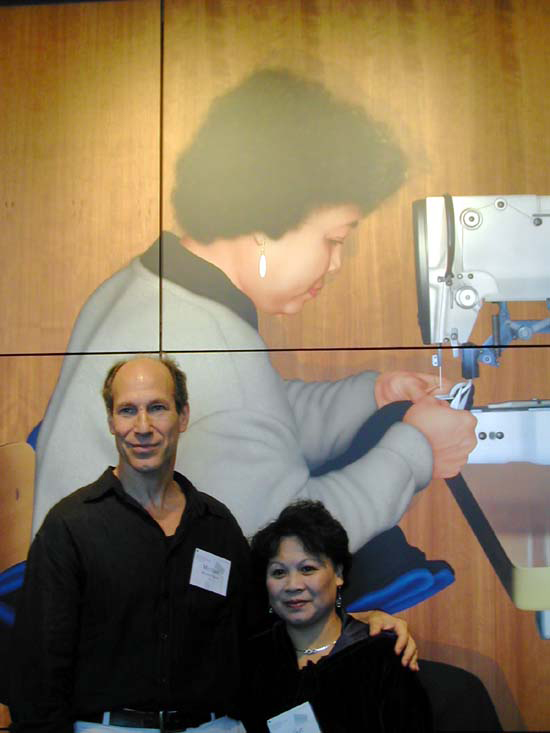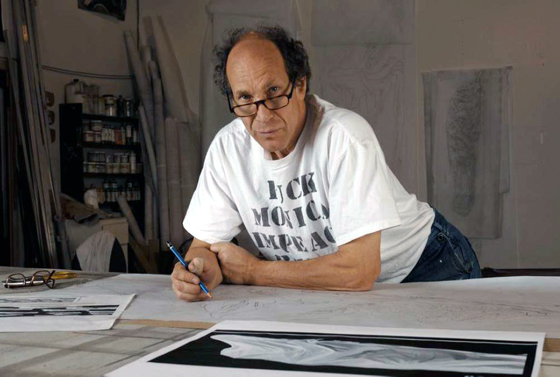| |||||||||
|
|||||||||
| Michael Fajans 1947-2006
Fajans’ most impressive public work is the federally sponsored “Three Sets of Twelve,” a massive three-part meditation on the jury system installed in the lobby of the new Federal Courthouse in Seattle. The mural shows twelve people in their normal work life and shows them again, together as a jury. Expressing the individual and the collective qualities that together enable law to function in a democracy, “Three Sets of Twelve” took five years to complete. It was installed at just the moment in American history when the executive branch was making a case for military tribunals to replace jury trials. One viewer wrote about the political coherence of the mural: “It is the most powerful and apt statement I've seen an artist make in a civic space. Whoever sees Michael's painting absorbs a message that each of us has a responsibility to participate in our society. Everyone who sees it understands the value that each of us brings to the justice process based on our life experience and common bonds as citizens” (Barbara Goldstein). Between 1980 and 2000, using a highly original style of airbrush acrylic composition employing photographs as source images that were enlarged, transformed and transferred to canvas with the use of stencils, Fajans produced more than fifty meticulously crafted large figural paintings that now exist in public locations and private collections, mostly in the Northwest (see the “Individual Paintings” section of this site). They depict human figures in a highly realistic manner and have been mistaken for photographs, although their backgrounds often experiment with a range of effects related to American abstract art. His work received three major showings at the Davidson Galleries, welcomed in each case by a devoted group of Seattle fans and critics. Sam Davidson was an unwavering supporter of Fajans’ work throughout his career. Sometimes viewed as uncompromising in his artistic program, there are several stories about strong negative reactions to Fajans’ paintings. A local CEO who admired his art hung "It's You" in the lobby of his corporate headquarters on loan, but soon returned it to the artist because of the hostile reaction of his employees. He was sincerely concerned that they might damage the painting. Undaunted, Fajans entered the painting a few months later in the Northwest Annual, a showing of work by artists from across the region at Seattle’s Center on Contemporary Art (COCA). It was the only painting in the competition that offered a highly refined realist depiction of an ordinary person in an ordinary situation—selecting a dress. Like most of Fajans’ paintings, this figural subject was in keeping with the performance strictures of Yvonne Rainer who said, “No to spectacle no to virtuosity no to transformations and magic and make-believe no to the glamour and transcendency of the star image no to the heroic no to the antiheroic . . . no to moving or being moved.” The guest curator of the COCA show, prominent New York gallery director Paula Cooper, chose "It's You" as best in show. Fajans returned to New York for various projects. He received a Bessie for his stage set for Brain Cafe, a play performed at LaMama ETC in 1987. With typical uninhibited inventiveness, he created a stage that interacted with the characters: walls moved to trap characters in closing corners; walls disappeared, leaving actors suddenly in a vast void; painted walls turned into mirrors. His grasp of theatrical staging is apparent in all his major works of public art. He carefully chose sites of some difficulty and allowed the setting to help determine his composition. “High Wire” is, for example, a 177-foot-long mural in the Seattle-Tacoma Airport designed to reveal the stages of a Vaudeville disappearance trick for travelers walking down Concourse D toward their planes. Fajans also had strong interests outside the arts, particularly motorcycling and volleyball. He took a long trip to the southwestern United States in 2005 on his BMW 2004 1150RT and had ridden another BMW regularly since 1966. He also was a skilled and intense volleyball player who competed at the “A” level in the United States Volleyball Association, and later with age classed teams at the USA Open National Tournament.
At the time of his death, Fajans was working on another large mural but without a sponsor or a known venue. Troubled by US military involvement in Iraq and by other positions of the current administration, he decided to create a vast paneled space with bodies in shrouds floating down an invisible curved river. He had completed an electronic draft of the entire composition based on photographs he had taken of twenty-one carefully positioned figures, wrapped in sheets. In an e-mail he explained, “I will create a stencil from each drawing and begin the painting process.” As he prepared to begin painting, he received notice that he was on the short list for another commission, a major project for the Chicago Transit Authority. He was someone whose inventiveness and artistic determination meant there was always plenty on the horizon still to accomplish. Fajans is survived by his partner of twenty years, artist and affordable artist housing developer Cathryn Vandenbrink, by his sister Trudi Fajans, a public health administrator in Seattle, and by his son, Pepper Fajans, a student at Sarah Lawrence College and an accomplished sculptor and performance artist in film, dance and magic. |
|||||||||
|
|||||||||
|
|||||||||
|
© Copyright Michael Fajans 2005-2017. All rights reserved. |
|||||||||








